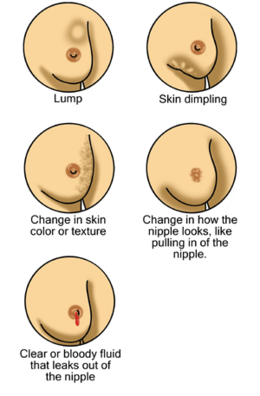Breast diseases make up a number of conditions. The most common symptoms are a breast mass, breast pain, and nipple discharge.[1]
A majority of breast diseases are noncancerous.[2]
YouTube Encyclopedic
-
1/3Views:31 90313 08412 901
-
Diseases of Breast: Part 1. Normal anatomy, Classification & FIBROCYSTIC CHANGES
-
Breast I: Benign Breast Disease
-
DISEASES OF BREAST Part 2: PROLIFERATIVE BREAST DISEASE
Transcription
Tumor

A breast tumor is an abnormal mass of tissue in the breast as a result of neoplasia. A breast neoplasm may be benign, as in fibroadenoma, or it may be malignant, in which case it is termed breast cancer. Either case commonly presents as a breast lump. Approximately 7% of breast lumps are fibroadenomas and 10% are breast cancer, the rest being other benign conditions or no disease.[3]
Phyllodes tumor is a fibroepithelial tumor which can be benign, borderline or malignant.
Breast cancer
Breast cancer is cancer of the breast tissues, most commonly arising from the milk ducts. Worldwide, breast cancer is the leading type of cancer in women, accounting for 25% of all cases.[4] It is most common in women over age 50.
Signs of breast cancer may include a lump in the breast, a change in breast shape, dimpling of the skin, fluid coming from the nipple, a newly inverted nipple, or a red or scaly patch of skin.[5] Diagnosis may also be made when the cancer is asymptomatic, through breast cancer screening programs, such as mammograms. Outcomes for breast cancer vary depending on the cancer type, extent of disease, and person's age.[6] Survival rates in the developed world are high,[7] with between 80% and 90% of those in England and the United States alive for at least 5 years.[8][9]
Fibrocystic breast changes
Also called: fibrocystic breast disease, chronic cystic mastitis, diffuse cystic mastopathy, mammary dysplasia
Infections and inflammations
These may be caused among others by trauma, secretory stasis/milk engorgement, hormonal stimulation, infections or autoimmune reactions. Repeated occurrence unrelated to lactation requires endocrinological examination.
- bacterial mastitis
- mastitis from milk engorgement or secretory stasis
- mastitis
- chronic subareolar abscess
- tuberculosis of the breast
- syphilis of the breast
- retromammary abscess
- actinomycosis of the breast
- duct ectasia syndrome
- breast engorgement
Other breast conditions
- Mondor's disease
- Paget's disease of the breast
- nipple discharge, galactorrhea
- breast cyst
- mastalgia
- galactocoele
See also
References
- ^ Salzman, B; Fleegle, S; Tully, AS (15 August 2012). "Common breast problems". American Family Physician. 86 (4): 343–9. PMID 22963023.
- ^ "MedlinePlus: Breast Diseases". Archived from the original on 2016-07-05. Retrieved 2018-03-21.
- ^ Page 739 in: Mitchell, Richard Sheppard; Kumar, Vinay; Abbas, Abul K.; Fausto, Nelson (2007). Robbins Basic Pathology. Philadelphia: Saunders. ISBN 978-1-4160-2973-1. 8th edition.
- ^ World Cancer Report 2014. World Health Organization. 2014. pp. Chapter 1.1. ISBN 978-92-832-0429-9.
- ^ "Breast Cancer Treatment (PDQ®)". NCI. 23 May 2014. Archived from the original on 5 July 2014. Retrieved 29 June 2014.
- ^ "Breast Cancer Treatment (PDQ®)". NCI. 26 June 2014. Archived from the original on 5 July 2014. Retrieved 29 June 2014.
- ^ "World Cancer Report" (PDF). International Agency for Research on Cancer. 2008. Archived from the original (PDF) on 20 July 2011. Retrieved 26 February 2011.
- ^ "SEER Stat Fact Sheets: Breast Cancer". NCI. Archived from the original on 3 July 2014. Retrieved 18 June 2014.
- ^ "Cancer Survival in England: Patients Diagnosed 2007–2011 and Followed up to 2012" (PDF). Office for National Statistics. 29 October 2013. Archived (PDF) from the original on 29 November 2014. Retrieved 29 June 2014.
Further reading
- Irshad, A.; Ackerman, S. J.; Pope, T. L.; Moses, C. K.; Rumboldt, T.; Panzegrau, B. (2008). "Rare Breast Lesions: Correlation of Imaging and Histologic Features with WHO Classification1". Radiographics. 28 (5): 1399–1414. doi:10.1148/rg.285075743. PMID 18794315.
